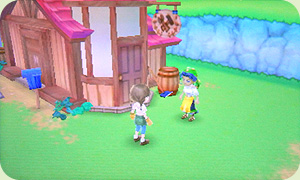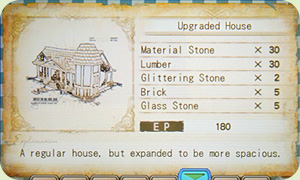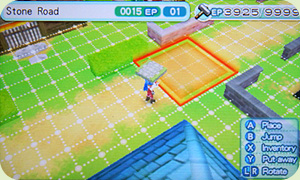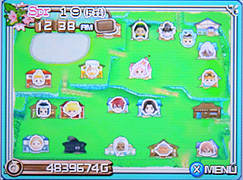Blueprint Basics

On Spring 25 of your first year, you will unlock Rebecca the craftswoman. She will visit your house and explain how to craft objects that you can place on your farm or in Echo Village. Rebecca will unlock the door on the side of your house, revealing the Studio. To enter the Studio, walk to the side of your house and press the A button.
The construction Studio allows you to build objects, such as decorations, roads, and houses, and then place them out for display. The Studio has a menu for Blueprints and a menu to Edit.
Blueprints
Rebecca will include some basic blueprints when you first unlock the Studio: Watering Spot, Road, the wooden fence set, the Gravel Field, and the basic tool blueprints. The remaining blueprints in the game come from other areas. You can receive blueprints from villagers, by catching them while fishing, from festival wins, and so on.
Some of the blueprints will become available after you have constructed a certain number of required objects. Receiving the objects from a trade does not count towards unlocking new blueprints. For example, the blueprint for the Tulip Flowerbed is unlocked at Rebecca's shop after you have made 10 Potted Tulips. If your blueprint inventory indicates that you have 10 Potted Tulips and yet you don't see the Tulip Flowerbed in her shop inventory, this may indicate that you received a Potted Tulip from the wifi trade system. Try constructing another Potted Tulip to see if you receive the letter in your mailbox announcing a new blueprint available at her shop.
To see your list of collected blueprints, you can simply press the X Button to open the main menu and then select Blueprint. To construct an item, you need to go into your Studio and select Blueprint; you can't build anything from your main menu.

After you receive the blueprint, you can typically make as many of that object as you want; however, you only can make one of each villager's house, the maker machines, and your inside farmhouse objects and size upgrades.
The materials required to make a blueprint can come from your storage or your rucksack. The game will automatically pull from your storage first and then your rucksack. The Studio will also craft items that have the lowest star rank if the items are in the same location. For example, if you are making Potted Pink Roses and you have 5-star Pink Roses in your Storage and 2-Star Pink Roses in your rucksack, the Studio will use the 5-Star roses since they're in the default material location. If you have the 2-Star and 5-Star Pink Roses in Storage, the Studio will use the 2-Star roses until it needs to use the 5-Star roses.
You can also ship the object for money. Just go to your Shipping Bin and select Ship from Inventory.
Edit
Using the Edit option is how you place (or remove) objects from your village and farm. If you just want to change your farm house wallpaper, carpet, or furniture style that you just constructed, you can go to the Storage box inside your farm house to modify your decor.
While editing, the ground will have a grid on it to help you lay out your objects. Each object you construct will have an Edit Point (EP) value, and you can only place as many objects in the area as the available EP allows. You can see the current available and used EP in the upper-right corner while editing. On the bottom screen of your 3DS, you can see the amount of EP an object has. Typically the easier the object to construct, the less EP it has; e.g., a Wooden Bench is only 30 EP while a Bridge costs 225 EP.

Chances are that you'll never meet the EP limit of any area, but the EP limits are:
- Your West Farm: 2500 EP
- Your East Farm: 4000 EP
- Your Main Farm: 5000 EP
- The village areas: 9999 EP
In-game time will pause while you are in Edit mode! You can take as long as you want to place your objects.
To place an object, select it from your object inventory and then place it on the ground. If you see the area outline of the object in red, then there isn't enough room for the object to be set. This means that there is something in the object's path such as a tree sapling or another object. You can change your viewing angle to see what is around by pressing the directional pad on your 3DS. You can push other objects out of the way by pressing against them using your circle pad, but if they don't move then there is something blocking that object from moving. Tree saplings can't be cut down while you are in Edit mode, so you will need to return to your Studio and exit Edit mode, then go cut down the offending tree with your Axe. You can pick up lumber while in Edit mode though.
Most of the objects can be placed in either the village area or your farm area, but there are some that are exclusive to one or the other. Fields can't be placed in the village, and villager houses cannot be placed on your farm. There are also object combos that can trigger special conditions when placed together.
Village Housing

In the case of villager housing, you must place the house into the village before the resident can move in. Sometimes ANB game players will build a house and then ask me why the person hasn't moved in yet.
When you start building houses during Town Restoration Plan #2, it may feel like there isn't enough room to place all of the villager housing. You may need to cut down some trees and move other houses to make room. Once you begin Town Restoration Plan #3, Dunhill will unlock the tree-filled western village area. You can then clear the area and use it for additional housing development.
Remember that the roads are also objects in the game. The road area takes up more room than they visually appear to be, so if you are having problems placing a villager house then try pulling up some of the nearby road pieces.
There is enough room to place all of the villager housing in the main village area if you are creative with your placements.